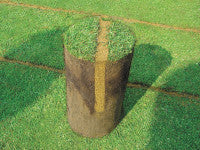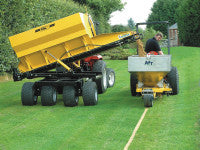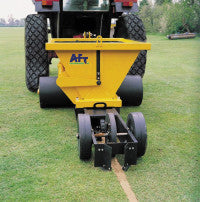Slit Drainage
 You cannot make a silk purse out of a pig's ear. If there is not enough finance available to put in the necessary degree of drainage, it is no good thinking that half-measures will fully meet requirements. Inadequate work is often claimed to have brought about some improvement, but excuses have to be proffered when, inevitably, wet ground conditions still prevail following seasonal rainfall.
You cannot make a silk purse out of a pig's ear. If there is not enough finance available to put in the necessary degree of drainage, it is no good thinking that half-measures will fully meet requirements. Inadequate work is often claimed to have brought about some improvement, but excuses have to be proffered when, inevitably, wet ground conditions still prevail following seasonal rainfall.
When funds are in short supply, as is often the case, it is usually better to deal effectively with (just perhaps the worst) part of an area rather than attempting to deal with all of it inadequately. A full cure on one part demonstrates the validity of the work and is a clear reason for more of the same on other parts.
Although there are other factors that have to be taken into account, the two main reasons why some slit drains are not good enough are:
1. They are too widely spaced.
2. Unsuitable back-fill has been used.
Slit Spacing
Water movement through any granular material, be it soil, sand or gravel, is not a rapid flow; it is only continuous slow seepage. The rate at which this water movement takes place varies with each different material and it is known as the material's Hydraulic Conductivity. It is normally expressed as the height of a column of water, which has been able to pass through the material in a given time.
For example, a good drainage sand can provide a tested figure of 150cm /hour or more. Unsuitable sands, such as concrete sand, may give say only one fifth of this drainage rate and, though comparatively cheap, are most certainly not cost-effective. In purchasing any sand for drainage purposes it is essential to know it's Hydraulic Conductivity. Any competent supplier should be able to provide this figure.

Because water does takes time to move along individual slit drains, there has to be enough of them in order quickly to remove substantial precipitation from the surface. Slits at 2 metre centres can only cope with half the quantity of water that slits at 1 metre centres can deal with. Some of the not-so-good schemes even have slits at 5 metre centres! So fully effective slit drains have to be intensive.
Slit Dimensions
The wider and deeper the slits, the more water they can carry. But, just as smaller slits are less costly per metre run, larger slits are more costly. Today's modern specialised equipment provides the ideal cost-effective remedy. For example, major slits, say 45mm wide x 250mm deep at say 2m centres and at 90 degrees to the pipe drains, with these in turn crossed by minor slits, say 20mm wide x 125 mm deep at say 250mm centres. This means that no surface water is more than 125mm away from a slit that is part of an interconnecting drainage matrix.
Backfill
The type and quality of the slit backfill material is a crucial factor in the effectiveness of an installation.
Good quality sand is essential. Although granular materials, such as pea gravel may give quick and immediate results, they most definitely should not be employed as slit to-surface backfill. The comparatively large size of the granules does mean that the pore spaces between them are big enough to give rapid permeability when first installed. Unfortunately, because they are large, these same pore spaces allow very easy access for soil particles to migrate into them. Permeability is soon reduced to zero because all the voids are blocked. This means that those slit drains that are backfilled with gravel only give a very short-term benefit - a poor cost option.

Sand is much more difficult to deal with than gravel. Bagged kiln dried sand does flow easily but the cost of the appropriate quantities is totally prohibitive. Bulk sand tipped on site tends to be moist, and this means that it is very difficult to make it flow from hoppers and into slits. However, specialised modern equipment can now handle moist sand efficiently.
Manufacturers of those machines that cannot handle moist sand may advocate using gravel, but this really is not good practice. Also, gravel on the playing surface is clearly unwanted. Inserting it into the soil of the root-zone is seriously detrimental to its texture, whereas adding sand is entirely beneficial.
A sand with suitably high hydraulic conductivity gives the best of both worlds.
It provides good permeability and long-term benefit. The small size of its pore spaces means that it is difficult for fine particles to infiltrate into them and the voids are so numerous that there is high permeability initially and in the longer term.
Under Drainage
Water in slit drains takes time to move laterally. The bigger the slits and the better the backfill, the quicker and farther the water moves. Also, the shorter the distance to the discharge points, the greater the drainage rate that is provided. Discharge is normally into the backfill over pipe drains. A common reason for unsatisfactory slit drainage is that these pipe drains are too far apart. For example, it is unrealistic to expect pipe drains at 10 metre centres to be adequate. Centres at 5 metres would only be at all feasible if the crossing Major Sand Slits were very substantial. Pipe drains at closer centres are more effective.
Maintenance

Apart from dealing with obvious points such as blocked outfalls, collapsed pipes, full silt traps, etc., an important requirement is the maintenance of good permeability in the back-fill. All drainage slowly deteriorates due to the infiltration of fine particles.
The continuing performance of slit drains depends directly on the continuing permeability of their backfill. Gradual capping of the slits by soil is inevitable and this prevents the entry of surface water. Measures to counter this are an essential part of maintenance.
Fortunately, specialised equipment is now available which can very quickly install new fine neat slits at 90 degrees across existing slits and re-connect them to the surface. Because these machines have a very high output, costs are moderate.
For example, it is possible to install 40,000 linear metres (25 miles!) of these minor slits on a rugby pitch or golf fairway in as little as one, or sometimes two, days. The work is so neat that golf greens can also be dealt with.
Scheme Design

It is possible to calculate exactly what the optimum specifications of any drainage installation should be in order to provide the most cost effective design. Whilst theory has to pay due heed to practical experience, calculated figures are realistic facts, whereas words can be merely convenient. Hit-and-miss is a poor approach. Too much drainage work has been installed on a hearsay basis, or as a result of over-confident and unjustified recommendations.
Slit Drains
A Slit Drainage System can compare very favourably with much more expensive Profile Replacement installations. The use of natural soil gives a stronger, healthier turf and a better playing surface.
Although this is entirely true of well designed intensive slit drainage, it is not realistic to expect inadequate schemes to provide a similar high performance.
Geoffrey Davison has for many years been a pioneer in evolving the theory and practice of the techniques which are now in general use in Britain, Europe, The United States, Australia, New Zealand, Canada and other countries world-wide.
Always keenly interested, he is happy to be telephoned regarding any query or to provide further information. Telephone 01568 797024
Article Tags:
Consultancy